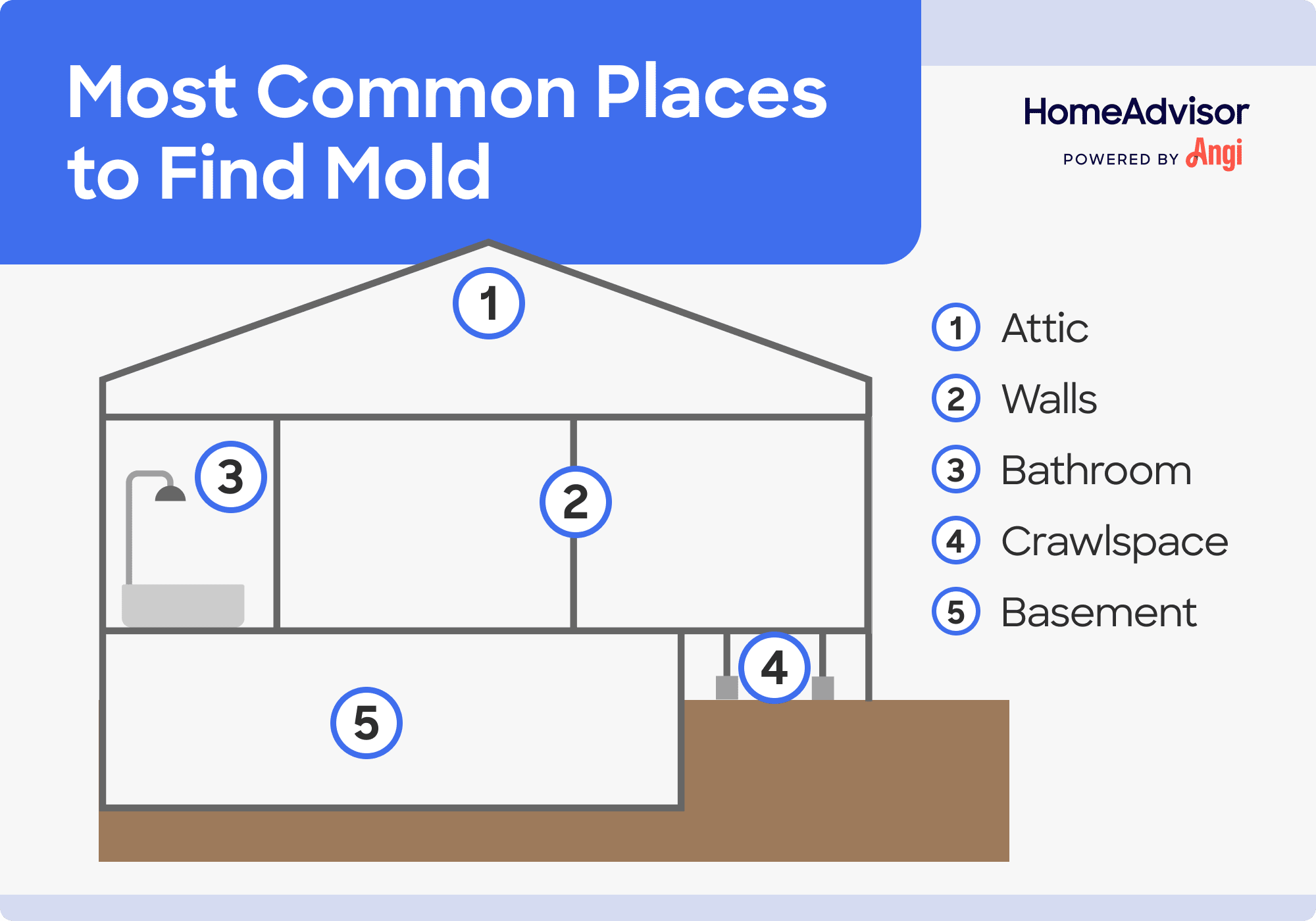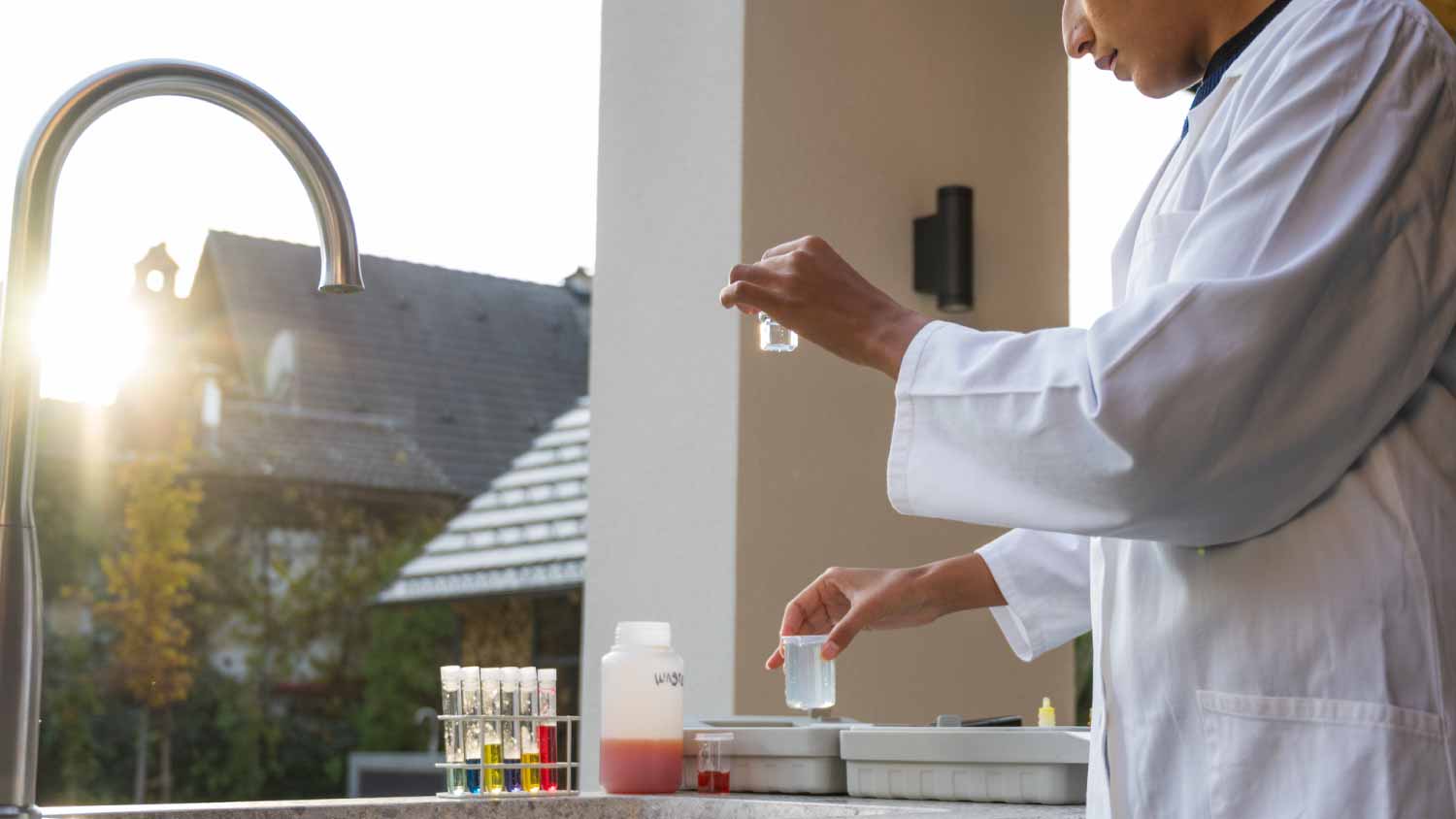
Budget for mold remediation costs based on factors such as severity, location in the home, type of mold, damage type, and more.
A mold inspection costs an average of $671


A mold inspection costs an average of $671, with most homeowners spending between $303 and $1,045. Costs can be as low as $150 or reach $2,999 in some cases.
Your mold inspection cost depends on factors like testing type, mold type, home size, and the location’s accessibility.
Hiring a professional inspector to check your home for mold ensures thorough and accurate results.
This article was updated using automation technology and thoroughly reviewed for accuracy by HomeAdvisor Editor Ryan Noonan.
Mold inspection is an essential preventive measure for homeowners. Mold inspections cost between an average range of $303 and $1,045, or $671 on average. Factors like location, home size, mold type, and testing type all impact the final price. Budgeting wisely and hiring a professional ensures reliable detection and peace of mind, especially when scheduling regular inspections for long-term protection.
As you begin your research on mold inspections, you'll quickly find that flat rates aren't the norm. Several factors can affect your final cost, including your home size, location accessibility, and the mold type you're potentially dealing with.
On‑site mold testing runs $250 to $500. During the visit, the inspector collects air or surface samples to confirm the presence of mold, identify the species, and measure the spore count—critical details that your professional will use to plan remediation.
Many inspectors also send samples to a lab, and pricing depends on the test method. For example, a stain test costs an average of $150, whereas a mold culture test adds $50.
Additionally, fees vary by the sample type used. The inspector will gather several pieces of household material and physically take them to an independent lab for testing. Depending on the type and number of different collection methods used, lab testing of mold samples can add additional costs, as laid out in this table.
| Sample Collection Method | Average Lab Testing Cost |
|---|---|
| Swab sample | $200–$300 |
| Carpet sample | $50 |
| Air sample | $250–$350 |
| HVAC test | $50–$75 |
Home size plays a big role in your final inspection quote. Mold inspection costs can range from $150 to $2,992 overall. Homes under 4,000 square feet incur inspection costs between $300 and $400, while larger homes often cost between $700 and $1,000. The more ground an inspector has to cover, the more you can expect to pay for the inspection.
Most mold colonies are easy to spot, but growth tucked behind walls, under flooring, or inside ductwork takes extra time—and therefore extra cost—for an inspector to confirm.
Expect to spend $450 to $800 or more for an inspection that covers every mold type. If your mold inspector suspects there’s black mold in the home, the cost of your inspection may be even higher because they’ll have to take more care and use protective equipment to conduct the assessment.
| Mold Type | Average Cost Range |
|---|---|
| Alternaria | $450–$550 |
| Aspergillus | $450–$550+ |
| Aureobasidium | $450–$550 |
| Chaetomium | $450–$550 |
| Cladosporium | $450–$550 |
| Fusarium | $600–$800 |
| Penicillium | $500–$600 |
| Serpula lacrymans | $500–$600 |
| Stachybotrys chartarum | $600–$800+ |
| Trichoderma | $500–$600 |
| Ulocladium | $500–$600 |

If you think mold might be lurking in your home, check for these red‑flag warning signs.
Bathrooms, basements, closets, and other wet areas are popular hangouts for mold. It could be a sign of a more significant issue if you smell a musty odor coming from any of these spots.
Mold is often visible. Mold can appear as white, fluffy threads or as clusters of tiny black spots.
Old water damage and long-term exposure to moisture will lead to mold. If you see water stains or discolorations on walls or ceilings, or if you notice bubbling or cracking paint, you could be dealing with water damage.
Anywhere there is moisture, you're likely to find mold. In the case of water leaks, the evidence of an issue isn't always where you can see it. Damaged floors, sagging ceilings, and strange noises in your plumbing are good indicators of a water leak.
Any home with past flooding will almost always have mold issues. In this case, a mold inspection is crucial.
Chronic mold exposure can lead to several health issues, including skin allergies, nasal congestion, persistent coughs, and an overall uptick in your allergy and asthma symptoms.
A few quick prep steps help your inspector get accurate readings:
Stop all exterior ventilation: In the 24 to 48 hours preceding the examination, close all windows and keep doors closed.
Turn off your HVAC system: Be sure to turn off your HVAC system at least two hours prior to your inspection time.
Turn off any appliances that affect your indoor air: If you have air purifiers, air cleaners, whole-house humidifiers, or dehumidifiers, turn them off 24 to 48 hours before your inspection.
Pause any cleaning and landscaping projects: Landscaping, vacuuming, dusting, and sweeping can all affect mold readings.
Clear away clutter: Remember that a home inspector will likely examine the nooks and crannies of your home, where mold tends to thrive.
While an inspection costs far less than full remediation, repeat visits can add up. Try these tactics to keep your budget in check:
Book an inspection as soon as you spot a problem—the longer you wait, the pricier it gets.
Bundle a mold inspection with remediation services to lower the costs of both services.
See if your homeowners' insurance offers coverage for hiring mold testing pros and remediation services.
Save money by skipping DIY home tests and investing in comprehensive, professional testing.
Reduce the risk of mold by keeping humidity low in potential problem areas, such as basements and bathrooms.
No place is more important than your home, which is why HomeAdvisor connects homeowners with local pros to transform their houses into homes they love. To help homeowners prepare for their next project, HomeAdvisor provides readers with accurate cost data and follows strict editorial guidelines. We surveyed thousands of real customers about their project costs to develop the pricing data you see, so you can make the best decisions for you and your home. We pair this data with research from reputable sources, including the U.S. Bureau of Labor Statistics, academic journals, market studies, and interviews with industry experts—all to ensure our prices reflect real-world projects.
From average costs to expert advice, get all the answers you need to get your job done.

Budget for mold remediation costs based on factors such as severity, location in the home, type of mold, damage type, and more.

Curious who installs radon mitigation systems? Learn who to hire, why specialists matter, and what radon mitigation costs so you can take safe action now.

Not sure who to call for mold removal? See when to hire a mold specialist or restoration pro, plus costs and steps to expect.

Curious who to call for a mold inspection? Discover mold inspection costs, pro options, and what to expect before you book.

Find who to call to test water for lead. Learn when to hire a certified water testing professional or state-certified laboratory and what to expect.